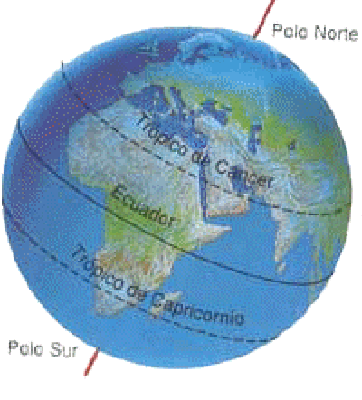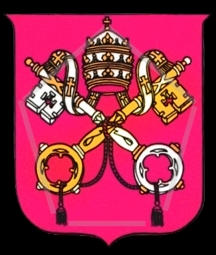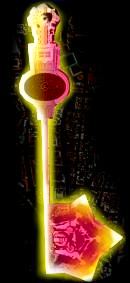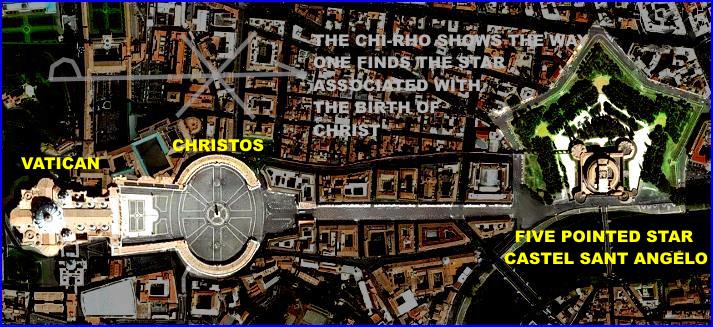|
Rispondi |
Messaggio 1 di 113 di questo argomento |
|
El Día de las Madres Judías
Un Mensaje de Torá para el 11 de Jeshvan el iortzait (aniversario del fallecimiento) de nuestra matriarca Rajel
Rajel
Rajel es la matriarca espiritual del Pueblo Judío, que fue esparcido por el mundo.
Rajel personifica el clamor por el retorno espiritual y físico de todos los judíos.
Rajel es la que se reusa a ser reconfortada hasta que se concrete el retorno de sus hijos (Jeremías 31:14)
El 11 de Jeshvan ha sido declarado el “Día Internacional de la Unidad de la Mujer Judía”.
A continuación ofrecemos una explicación profunda y conmovedora del simbolismo relacionado con Rajel Imeinu.
Nuestra matriarca Rajel, la esposa amada de Iacov, personifica para el pueblo judío el poder innato del alma y su devoción conciente de despertar la misericordia de Di-s para redimir a Sus hijos del exilio y traerlos a la Tierra Prometida. Esto lo hace con lágrimas y plegaria sincera.
En las Palabras del profeta Jeremías:
Así dice Di-s:
“Una voz es oída en Ramá, lamentación y amargo llanto; Rajel llora por sus hijos, se niega a ser reconfortada, por sus hijos, que no está.”
Así dice Di-s:
“Guarda tu voz del llanto, y tus ojos de las lágrimas; porque hay recompensa por tu esfuerzo, dice Di-s; y ellos volverán de la tierra del enemigo. Y hay esperanza para tu futuro, dice Di-s, y los hijos volverán a su frontera.”
Recitamos esta profecía como Haftará (lectura sabática de las escrituras a continuación de la lectura de la sección correspondiente de la Torá) del segundo día de Rosh HaShaná.
Rosh HaShaná, el “día de recordación”, es el día en que Rajel, después de haber sido estéril por muchos años, fue recordada por Di-s para tener un hijo. Treinta años después, en el mismo día de Rosh HaShaná, ese hijo Iosef fue liberado de la prisión y nombrado virrey de Egipto.
La frase de la profecía “por sus hijos, que no está”, en donde Rajel llora, se refiere en particular a su hijo Iosef , el representante espiritual de las tribus exiliadas de Israel.
En cabalá se enseña que los doce meses del año judío tienen dos rosh, "cabezas" o meses “padres”: el mes de Nisan es el “padre” de todos los meses del año, mientras que Tishrei es la madre. El shofar de Rosh HaShaná simboliza en cabalá el útero materno, y su sonido el nacimiento de un nuevo (y bendito) año.
El valor numérico de Rosh HaShaná, 861, equivale a la suma de todos los números del 1 al 41 (denominado matemáticamente el “triángulo” de 41), siendo el número 41 el valor numérico de la palabra em (“madre”). 861 es también el valor de beit hamikdash (“el Templo Sagrado”), que para la mujer, la madre, simboliza la casa y la construcción de un santuario sagrado para su familia.
Antes de hacer sonar el shofar en Rosh HaShaná, meditamos sobre el nombre de Di-s de 22 letras, cuyo valor numérico es 1681, el cuadrado de 41. Este es el Nombre que está codificado en la bendición sacerdotal, la fuente de toda bendición para un año bueno y dulce.
El Iortzait (aniversario del falecimiento) de nuestra matriarca Rajel cae el 11 de Jeshvan, el mes que sigue a Tishrei, y como este siempre posee 30 días, esta fecha es el día 41 desde el comienzo del año, por eso es el iom haem (día de la madre).
Este período completo de cuarenta y un días puede entonces ser entendido como una continuación y extensión del servicio espiritual de Rosh HaShaná (que es la suma del 1 al 41 como ya dijimos). El iortzait de Rajel es la consumación del nacimiento del año desde el útero materno. En este mismo día da a luz a su segundo hijo, Biniamín, devolviendo en el parto su alma al Creador.
Enseñan nuestros sabios que “los portales de las lágrimas nunca se cierran”; en la plegaria de la medianoche, conocida como tikun Rajel (“la rectificación de Rajel”), reflexionamos que el nombre “Rajel” equivale a 238, que es igual a 2 x 119, siendo 119 el valor numérico de la palabra dimá, “lágrima”.
Así, nuestra madre Rajel personifica las dos lágrimas “cósmicas” de la Shejiná (la presencia inmanente y revelada de Di-s en nuestro mundo), que brotan de sus ojos y despiertan la misericordia sobre el pueblo de Israel.
Estas dos lágrimas corresponden a los dos días de Rosh HaShaná (la haftará de Rajel se lee en el segundo día, cuando ambas lágrimas ya han sido derramadas).
La palabra “lágrima”, 119, equivale numéricamente a la palabra meat (“pequeño” o “poco”). Di-s prometió al pueblo judío que va a expulsar a nuestros enemigos de nuestra tierra, que vamos a heredar y asentarnos en ella “poco a poco” (meat meat). A pesar de que la Torá declara explícitamente que esto significa “no en un año…”, el proceso puede acelerarse por cierto de acuerdo a nuestros méritos.
El proceso que condujo a la redención de Iosef, el hijo de Rajel, no tomó un año sino dos, y cada uno de ellos pueden verse como correspondiendo a una de las lágrimas de Rajel.
Por otro lado, la frase “poco a poco” en si alude al servicio espiritual que ayuda a acelerar nuestra redención y heredar nuestra tierra, según la amplitud con que el alma judía (como pueblo, los hijos de Rajel) reconoce su “pequeñez” existencial y ´por ende su anulación frente a Di-s. Al recibir Su bendición, entonces El contestará rápidamente nuestras plegarias y nos reunirá con nuestra tierra natal, para cumplir nuestro destino y Su propósito de la creación.
Así encontramos que Di-s nos ama y nos elige porque “tu eres la más pequeña (meat) de todas las naciones”, que nuestros sabios interpretan como: “ustedes se consideran pequeños”.
Aprendemos también en jasidut [Igueret HaKodesh 21, al final> que a través de repetidos actos de caridad la Shejiná (personificada por Rajel) “nos sacude el polvo del exilio” meat meat, y nos eleva a nuestra completa estatura espiritual.
La palabra “sacudir” (mitnaer) puede leerse como “ser rejuvenecido” (la raíz naar significa “joven” y la forma gramatical reflexiva mitnaer significa “volverse joven nuevamente”). Al derramar dos lágrimas y experimentar pequeñez espiritual, rejuvenecemos personalmente y a nivel de pueblo.
Encontramos en el Zohar: “Aquel que es pequeño es [verdaderamente> grande”. Cuanto más pequeños somos a nuestros ojos, más grande aparecemos a los ojos de Di-s (y de hecho, a los ojos de las otras naciones).
Cada lágrima de nuestra madre Rajel alimenta en la conciencia de sus hijos el sentido de meat. Alimenta nuestra conciencia con sus lágrimas y nos lava, limpiándonos de nuestras imperfecciones espirituales.
La palabra “madre” (em) se escribe igual que “si” (im). El profeta Isaias dice: “Si (im) Di-s ha lavado la suciedad de las hijas de Zion…”, dando a entender que es el principio “madre” (personificado por nuestra matriarca Rajel, que en particular es conocida en cabalá como “la madre inferior”, la sefirá de maljut, cuyo Nombre Divino es Adnut, el Nombre de Di-s que aparece en ese versículo) que lava y limpia la suciedad de las hijas de Zion, las almas de sus hijos.
Ahora podemos visualizar a una de las dos lágrimas de Rajel como nutriendo nuestra conciencia desde adentro, y la segunda lavando nuestras almas desde afuera. Cada una corresponde a un estado de pequeñez, la primera al estado de nuestra pequeñez existencial innata frente al Todopoderoso infinito, y la segunda al reconocimiento de nuestro distanciamiento de Di-s (el más alejado, el más pequeño) debido a nuestras propias iniquidades.
Cuando este estado de conciencia completo y rectificado y reconocimiento es integrado dentro de nuestras almas, la palabra meat se invierte para transformarse en taam (“sabor”), el buen “sabor” de los secretos de la Torá, que son revelados por el Mashíaj, sea Su voluntad que venga y nos redima pronto en nuestros días. Amen.
http://www.dimensiones.org/canales/vidmodrn/viviendo%20con%20el%20tiempo/JESHVAN/Rajel.htm
|
|
|
|
Rispondi |
Messaggio 39 di 113 di questo argomento |
|
"... Rachêl y ... Lea, las cuales dos edificaron la casa de Israel;..." (Rut, 4: 11).
|
|
|
|
Rispondi |
Messaggio 40 di 113 di questo argomento |
|
Por qué Iaakov amaba a Rajel… pero por qué tuvo que casarse también con Lea
 La Torá describe a Rajel como una chica con características muy hermosas y una piel muy bella, y a Lea como a una chica con ojos tiernos (Génesis 29:17). Es inusual para la Torá derramar tinta en ilustrar a la gente y lugares que menciona. La Torá describe a Rajel como una chica con características muy hermosas y una piel muy bella, y a Lea como a una chica con ojos tiernos (Génesis 29:17). Es inusual para la Torá derramar tinta en ilustrar a la gente y lugares que menciona.
Es también inusual que Lea es (aparentemente) públicamente menospreciada. Como principio, la Torá da toda una vuelta para evadir descripciones críticas innecesarias, y aún así, contrasta abiertamente la belleza de Rajel y los ojos de Lea. A la luz de este principio, el comentarista bíblico Rashi deduce que los ojos tiernos de Lea aluden a su llanto incesable; sus ojos eran rojos y suaves por la cantidad de lágrimas que derramaba. Lloraba en la plegaria, suplicando a Di-s cambiar el curso de su destino. Ella estaba destinada a casarse con Esav, bruto y corrupto como era, y ella rezaba constantemente para que su destino sea cambiado.
Tan potentes fueron sus plegarias que se terminó casando con Iaakov en vez de Esav. El Talmud muestra a Lea como el paradigma de la plegaria efectiva porque su comunicación con Di-s reescribió el guión de su vida. Ella es identificada por la Torá con sus lágrimas, una expresión de entusiasmo fresco y de lícita sinceridad de su irresistible plegaria. Cada día alzaba su voz hacia el cielo, y sus palabras nunca quedaron obsoletas de tanta repetición.
Más tarde, cuando Lea estaba embarazada de su séptimo hijo, ella le rezó a Di-s para que no fuera un hijo varón, ya que no sería apropiado que ella sea meritoria de la mayoría de los doce hijos destinados a Iaakov y que su hermana Rajel sólo contribuyera con uno. Milagrosamente, el feto masculino en su útero invirtió su sexo y se convirtió en una niña, Dina. Una vez más, las plegarias de Lea, como una flecha perfectamente en posición, llegó derecha hasta el cielo y su destino se cambió.
El gran Rebe y Cabalista Rabí Shneur Zalman de Liadi explica que el alma de Lea emergía del mundo del pensamiento mientras que el alma de Rajel provenía del mundo del habla. Lea era introspectiva, jefa de la meditación y de la comunicación interna, cavando en lo más interno de su alma y siempre emergiendo con una nueva apreciación descubierta de Di-s. Era el paradigma de la humildad y la inocencia; sus ojos tiernos de una corriente de frescas emociones.
Rajel era diferente. Ella era una comunicadora, carismática, y atractiva para los demás. Ella demandaba una esfera de influencia. Sus hermosas características aluden al brillo de su rostro. Su nombre hebreo, Rajel, equivale numéricamente a la frase “Vaiehí or”, “Y hubo luz”, que es 238. Con Rajel había luz, el ambiente se iluminaba con su presencia.
Esto explica la dramática reacción inusual de Iaakov hacia Rajel. Momentos luego de conocerla, “Iaakov besó a Rajel, alzó su voz y lloró”. Iaakov se dio cuenta de que estaba destinado a construir una familia que se convertiría en el pueblo elegido, la nación que sería una luz en el mundo. Sus doce hijos tendrían que alzar la antorcha de la moralidad y espiritualidad en un mundo que casi siempre se resistiría a este mensaje. Y aquí estaba Rajel, un carácter perfectamente adecuado para el trabajo. Ella podría ser una madre y una novia de una familia de efectivos comunicadores.
¿Por qué Iaakov alzó su voz y lloró? Aquí también explica Rashi, basado en el Midrash. Iaakov vio en Rajel a la perfecta esposa y a la perfecta madre, pero lo que lo turbaba era saber que Rajel no sería enterrada con él. Entendía que la falta de su póstuma unión reflejaba una falta de perfección en su misión compartida. Esto lo asombraba y entristecía, y por eso lloró.
Lo que Iaakov no se dio cuenta era que el componente que faltaba en la construcción de su familia y en la nación Judía era Lea. Rajel pudo haber contribuido al Departamento Judío, pero se necesitaba de Lea para agregar elementos a la genuina e introspectiva plegaria. La cualidad de comunicación de Rajel e influencia en el mundo sería necesitada más que nada cuando sus hijos estuvieran en Galut, exilio, en un ambiente desprovisto de ayuda fuera de Israel. Las cualidades de Lea serían necesitadas cuando los judíos estuvieran a salvo, ocupados en desarrollar su relación con su Creador.
Iaakov pensó en su tiempo de Galut, y vio a Rajel como la perfección. Pero tan pronto su familia abandonó Jarán, (su galut personal), y viajó hacia la Tierra Santa de Israel, su esposa Rajel murió, se completó su misión. Dejó a Iosef, el hijo que heredó su capacidad de crear una esfera dinámica de influencia. Él dirigiría a un país entero hacia la prosperidad. Los hijos de Lea, en contraste, pasaron la mayor parte de su tiempo como pastores, meditando en sus pasturas mientras caminaban al lado de su rebaño. Incluso en Egipto ellos vivían una vida aislada en la ciudad de Goshen.
Ambas Rajel y Lea eran las madres de la nación Judía. Rajel inculcó en nosotros la fuerza de destilar el poder y de alcanzar el aura de influencia. Lea nos otorgó la fuerza de tirar de las cuerdas de nuestra alma y de hablar con Di-s con integridad.
Por Rojel Holzkenner, extraído de chabad.org
|
|
|
|
Rispondi |
Messaggio 41 di 113 di questo argomento |
|
|
RELACION DE SIRIO CON ROMA
|
|
|
|
Rispondi |
Messaggio 42 di 113 di questo argomento |
|
|

The 11th of the month of Cheshvan comes in October or early November, at the height of autumn, when leaves fall, rain pours, and animals and plants slow down for the winter. It is a time when the world appears to die, yet the root of life remains, ready to sprout forth when the spring comes again. In Jewish legend, this date marks the death of Rachel, the mother of Israel—Rachel dies in childbirth as her son Benjamin is born. Mystically, Rachel represents the Shekhinah—the motherly presence of God that exists within all things.1 Rachel’s death symbolizes the descent2 of the Shekhinah into the underworld—the deep internal places of the spirit. Yet in the book of Jeremiah, Rachel is the loving mother who, buried in her tomb, waits for her children, the Israelite people, to return from exile, so that she may be reborn in them.3 Rachel is the root from which new saplings will spring. The 11th of Cheshvan marks the new growth in the Divine root within us even in times of loss and destruction, just as Rachel is the root of her exiled children. It is the seed of Tishrei growing underground: we cannot see it, but we know it is there.
|

“There is hope for a tree:
if she is cut down, she will renew herself,
and her new shoots shall not cease,
though her roots are old in the earth
and her stump dies in the ground…”
—Job 14:7-8
Element: Gateway between Earth and Fire
Direction: North-West
Angel: Katriel
Sefirah: Keter (crown/the root of the Tree of Life)4
World: Assiyah (Body)/Atzilut (Spirit)
|
The Story of the Season
|
|
|
Rachel, the biblical matriarch, was one of four wives of the patriarch Jacob, and was Jacob’s most beloved wife. Jacob served her father Laban5 for seven years in order to win her hand. At the end of the seven years, Laban tricked Jacob and gave him the eldest daughter, Leah, instead. Jacob consented to work another seven years for Rachel. Yet Rachel remained barren for years, while Leah bore child after child.6 Finally, Rachel gave birth to two sons, Joseph and Benjamin.7 Rachel died while giving birth to Benjamin. The story of her life shows how death and life, barrenness and growth, are inextricably linked. Like the goddess Inanna of Mesopotamian legend, who descends to her sister Ereshkigal who rules the dead,8 Rachel must descend to the underworld in order to bring new life. Jacob too must be exiled from his beloved Rachel for seven years—another kind of journey into darkness, in the service of life and union. Jacob becomes the root of the twelve tribes of Israel. So too, the Shekhinah goes into exile—into the places of our pain and suffering—in order to enliven us again. This is the theme of autumn—death in the service of new life.
|
"Our mother Rachel broke forth in speech and said before the Holy One; master of the universe, it is revealed and known before You that Your servant Jacob cherished a great love for me. Because of me, he worked for my father seven years. When the time for the marriage to my husband arrived, my father conspired to substitute my sister for me. Yet I was not jealous of my sister and did not expose her to shame. Now if I, who am flesh and blood, dust and ashes, was not jealous of my rival, then why should You—the living, merciful, and enduring king—be jealous of idols with no ultimate reality, and banish my children because of them?
"At once the mercy of the Holy One crested, and he said: 'for your sake, O Rachel, I will restore Israel to their place.'" —Lamentations Rabbah 24
|
|
A rabbinic legend tells that when God exiled Israel from its land for the sin of worshipping other gods, all the patriarchs tried to convince God to relent, without success. Yet Rachel pleaded before God that she had not been jealous of her sister when Leah married Jacob.9 If Rachel could manage not to be jealous of her flesh and blood sister, Rachel argued, why should God be jealous of statues and pillars, which did not threaten God in any way? God redeemed the people because of Rachel’s plea.10 Rachel represents the truth that the Divine within us is loving, compassionate and unselfish. She transforms severity into compassion and despair into hope. So too, Chassidic tradition teaches that through acts of love, the Shekhinah will rise from her exile and “shake off the dust”—through kindness, the root of creation ceases to be hidden.11
|
|
|
For centuries, Jews have celebrated the 11th of Cheshvan with pilgrimages to Rachel’s tomb in Bethlehem. In modern times, women go to Rachel’s tomb in Bethlehem to pray for relief of barrenness or for safe childbirth. They wind red threads around the stone that is Rachel’s grave marker, and bring them home to wear or tie around the belly, as a charm. The red threads associated with Rachel are symbolic of the thread of life.
Schoolchildren in Israel celebrate the 11th of Cheshvan as a kind of Mother’s Day, celebrating their own mothers as they honor Rachel, the mother of Israel. In fact, the 11th of Cheshvan falls forty-one days after Rosh haShanah (the new year)—in Hebrew, the letters that add up to forty-one (aleph and mem) spell out “eim” or mother.12 If the new year in Tishrei is the seed, the 11th of Cheshvan is the root, the mother, from which the new plant will grow.
|
"Let us see the light in others and honor that light.
remember the dead who paid our way here dearly, dearly and remember the unborn for whom we build our houses.
—Marge Piercy, "Amidah: On Our Feet We Speak to You" in Mars and Her Children (Knopf, 1982), p. 153-155.
|
Steps of the Season
|
|
|
In Israel, Cheshvan is the rainy season, and the months of Cheshvan and Kislev are associated with the story of the Flood. This story from Genesis tells of how God decided to destroy the world by flood because the humans upon it were corrupt and violent. God chose to save one man, Noah, and his family, by hiding them in an ark—a wooden box that floated on the waters.13 Many Near Eastern myths share the notion of a great flood. According to Jewish legend, it was on the 27th of Cheshvan that Noah, Naamah, and their children exited the ark—another kind of emergence from the underworld.14 The first of Kislev, according to some, is the day when the rainbow appeared as a sign, to announce that God would never again destroy the world. (In the Zohar, the rainbow indicates the sefirah called yesod—the realm of God that is about generativity, and foundation.) Noah’s family hide sin the ark in order to replant and repopulate the world, just as this season is a time of cold and retreat, but leads to new life in the spring. According to Rashi, the forty days of rain that cause Noah’s flood finish on the 28th of Kislev—just in time for the days to begin growing longer again.15
The 25th of Kislev marks the first day of Chanukah and the beginning of the festival of lights. Chanukah marks the rededication of the Temple after a civil war—an emergence from a dark time. In its essence, Chanukah is a festival celebrating the triumph of light over darkness. It is the emergence of the root from the ground. The 25th of Kislev also marks the time when the Israelites in the wilderness finished building the pieces of the mishkan, the dwelling place of the Shekhinah, but did not yet set it up as a single structure. So too, we piece ourselves together in the darkness, in preparation for the hard work of planting and harvesting that will come later.
|
In the evening your vision widens
looks out beyond midnight—
twofold I stand before you—
green bud rising out of dried-up sepal,
in the room where we are of two worlds...
—Nelly Sachs
|
Other Paths
|
|
|
Rachel’s yahrtzeit (death-anniversary) frequently falls near the Celtic or Wiccan holiday of Samhain, the day when the dead and the living can speak to one another.16 This same day is the Day of the Dead in Mexico, where people go to visit their loved ones in cemeteries, picknicking and celebrating with them. In Scandinavia, this day is the day of Hella, goddess of the underworld, when the living pray for Hella to open her halls so that they may see their loved ones. Catholicism refers to this day as All Soul’s Day, a time for remembering the deceased and praying for them. Like the 11th of Cheshvan, these are all festivals of connection with dead ancestors—with our roots. Crone-goddesses of death and rebirth, like the Welsh Cerridwen and Nicneven of Scotland,17 are honored at this time of year. Like these other festivals, the 11th of Cheshvan connects Jews to an ancestor-figure, Rachel, who embodies both death and the return to new life.
|
|
Ideas for Celebration
|
|
|
One way to celebrate Rachel’s yahrtzeit in an earth-based fashion is by visiting graves of our ancestors or making pilgrimages to sacred sites. We can visit elders and ask them to tell us stories, or we can tell stories of those we remember who have died. Another ritual might be gathering together to weave a web of red thread. Each celebrant takes the thread, says her or his name, and then tosses the thread to another woman while continuing to hold her or his section, so that a web is created. Then, while the group still holds the thread, the web is cut into equal pieces so that each person has a red thread to keep throughout the year as a sacred sign of life. We can also make this a time to tell Rachel’s story of childbirth and death, compassion and transformation to one another through dance, drama, or art. We can also go out and gather red autumn leaves, and make a collage or wreath honoring Rachel and the Shekhinah.
Another way to mark this sacred time is to light a yahrtzeit candle, representing the soul of Rachel, and to light the way of the exiled Shekhinah as she wanders in darkness. One can also go out on the 11th of Cheshvan and welcome the growing moon, using the ceremony of Kiddush Levanah, the sanctification of the moon (the 11th always falls as the right time in Cheshvan to do this), for it is written in the Talmud that “All who greet the new moon in its time are as if they greeted the face of the Shekhinah.”18 In the Zohar and elsewhere, the moon is the symbol of the Divine feminine, so greeting the growing moon is like welcoming the Goddess back from the realm of death and exile into the realm of light.
—Jill Hammer
Articles
|
|
|
|
|
Rispondi |
Messaggio 43 di 113 di questo argomento |
|
|
Cabalá y Vida Moderna- Viviendo con el Tiempo
Un Mensaje de Torá para el mes de Elul
del
Rabino Itzjak Ginsburgh
PREPARACIÓN para Rosh Hashanah
Este año (5768), el mes de Elul comienza el lunes 1 de septiembre del 2008
finaliza el lunes 29 de septiembre del 2008 (inclusive)
¿Se Puede Cambiar?
Elul es el último mes del calendario hebreo contando desde Tishrei. Su color asociado es el rojo de la sefiráh de guevuráh , “rigor” o “poder”, cuya experiencia interior es el temor o miedo. Como este mes precede a Rosh Hashanáh –el día del juicio universal- siempre ha sido una época de balance espiritual, durante el cual pasamos revista, hacemos un inventario de nuestra situación espiritual y moral, tratando de prepararnos lo mejor posible para semejante momento.
¿Quién no se estremece de miedo al enfrentarse a un juicio, como dicen los profetas: “El león ruge, quién no temerá?” ( Amos 3:8. En hebreo la palabra “león”, arié , tiene las mismas letras que “temor”, iráh .) Entonces el color rojo parece ir bien con el sentimiento que tradicionalmente llena nuestra experiencia en Elul, ya que en esta época este color simboliza la palabra “pare”.
Aunque todos sabemos que la trepidación y la ansiedad que sentimos por el inminente Día del Juicio no deben causar que se congele nuestro andar firme y decidido y que se estanque el proceso que tanto nos costó poner en marcha.
Todo lo contrario, debe llevarnos al camino del cambio.
Chiste Repetido
Pero, debemos reconocerlo, ¿No dijimos lo mismo el año pasado y el anterior y el anterior…? Sin lugar a dudas, cuando descubrimos por primera vez que existía algo llamado teshuváh –que existe una esperanza de cambiar, de transformarnos- hicimos lo mejor que pudimos para lograrlo. Pero la experiencia de tantos años nos ha enseñado que cambiar es muy difícil, o acaso absolutamente imposible.
No nos estamos refiriendo a agregar otros 15 minutos de Toráh cada día (aunque también esto es duro y valedero) u otras decisiones positivas, sino a un verdadero cambio de nuestro carácter, de transformar realmente la personalidad, de un cambio real en nuestra relación con el Todopoderoso.
Y así nos encontramos nuevamente en Elul, en el umbral de Rosh Hashanáh planeando realizar las acciones adecuadas para la ocasión. ¿Pero cuántos de nosotros aun creemos que podemos cambiar de verdad? ¿Cuántos de nosotros esperamos realmente reparar nuestra relación con nuestra esposa, con nuestros hijos, y la más importante de todas con el Todopoderoso? A veces parece que la ruta del cambio está llena de semáforos en rojo, hasta donde nuestros ojos pueden llegar a ver.
Entonces, este es el momento que entra en juego el mazal –la energía espiritual o llamado comúnmente signo- de Elul. Nos referimos a betuláh , virgo, la virgen, un símbolo de la frescura, la inocencia y la novedad. En la Toráh, la palabra “virgen” aparece como parte de la expresión “una joven virgen” (naaráh vetuláh) (Jueces 21:12, Reyes I 1:2 y Ester 2:3). En el Jumash (los Cinco Libros de Moshéh) aparece escrito sin la letra hei de la primera palabra, aunque se lee igual (ver Deuteronomio 22:23 y 22:28).
Sorprendentemente, el valor numérico de esta frase (intente calcular esta guematria antes de seguir leyendo) es 768, al igual que el del año que está terminando, taf shin samej jet (cabe aclarar que el año es 5768, pero los millares no se escriben generalmente cuando se hace referencia al año vigente). Entonces, este Elul es el mejor momento para meditar en el significado y la energía inspiradora a nuestra disposición durante los próximos 29 días, que nos ofrece una nueva esperanza para Rosh Hashanáh y para el año que comienza.
Si nos imbuimos de la fuerza y la convicción de la virginidad, acaso podremos decidir, por ejemplo, lanzarnos ya mismo, atravesando todas las luces rojas, hacia un futuro mejor.
Virginidad y Fortaleza
Como siempre, para comprender debemos meditar. Nunca está demás volver a aclarar que la meditación judía no buscar poner en blanco la mente sino todo lo contrario, el objetivo es utilizar de manera conciente nuestro intelecto para encontrar las asociaciones y paralelos entre lo espiritual, a Divinidad, el alma, la Toráh y la realidad material cotidiana en la que vivimos, sacar conclusiones y actuar en consecuencia.
Así, para poder integrar completamente la energía de la virginidad de Elul en nuestra psiquis, primero debemos estudiar; este es el camino de la Toráh y el judaísmo. Y como siempre debemos fijarnos en la primera aparición en la Toráh del tema que nos ocupa, en este caso la primera virgen, en el capítulo 24 de Génesis. Eliézer, el sirviente de Abraham, es enviado a encontrar una esposa adecuada para Itzjak, el hijo de Abraham.
La primera vez que Eliézer ve a Rivkáh, la Toráh la describe así (Génesis 24:16): “y la doncella era muy hermosa, era virgen y ningún hombre la había conocido; bajó al manantial, llenó su cántaro y regresó”. Cuando Eliézer le pidió agua, ella no sólo se la brindó, sino que también le ofreció abrevar a sus camellos, realizándolo sin dudar.
Evidentemente era una niña poco común. Los sabios nos cuentan que tenía sólo 3 años de edad. ¿Cómo podía una niña tan pequeña tener semejante autoestima para llegar a dar a agua a toda una caravana?
El Poder de Guevuráh
Para llenar esta brecha en nuestro entendimiento, los comentarios jasídicos ( Maor Vashemesh Jaiei Saráh sobre Vaikreú ) apuntan que el mayor atributo de Rivkáh era su poder, su guevuráh . Como ya dijimos, poder y el color rojo, de Elul, van juntos. Es el color de la sangre y por un lado simboliza la fortaleza necesaria para controlar nuestras inclinaciones, en la expresión de los sabios: “Quién es valiente, quien conquista su inclinación!” (por cierto, como tal simboliza el poder de “parar”).
Pero por otro lado, el rojo simboliza el calor y la fuerza de nuestras convicciones, calor que cataliza todo movimiento. El origen de la fortaleza de Rivkáh era su capacidad de proteger su virginidad o, como está referido a manera de eufemismo en la Toráh, su “fuente de sangre”. (Levítico 20:18. Por cierto, dam (“sangre”) proviene en hebreo de la misma raíz que “ adom ” (“rojo”). Creció en un ambiente promiscuo, lugar donde se necesita una tremenda convicción para aferrarse a los ideales propios.
Además, cuando le llegó el momento de acompañar a Eliézer de regreso a la casa de Abraham, enfrentó la oposición de su madre y hermanos con característico desafío, diciendo: “Iré”, dando a entender que “Iré con o sin vuestro consentimiento”. De hecho, la respuesta inflexible de Rivkáh, “iré” ( ilej ), equivale numéricamente en hebreo a “rojo” (adom )! El poder de Rivkáh es el símbolo de la virginidad.
La Virginidad Eterna
Pero la virginidad no es sólo un estado físico, es un estado mental. Hay varias explicaciones para el origen de la palabra virgen en hebreo ( betuláh ). Uno es que proviene de la palabra “hija” (bat ), con el agregado de un sufijo ( ulah ) que denota juventud. Pero como el valor numérico de estas tres letras agregadas es 41, igual que la palabra “madre” (em ), entonces “virgen” es igual a “hija madre”, (bat em ). La virgen hebrea sugiere una mujer que es a la vez hija y madre, indicando que no está limitada a un estado de virginidad física.
De la misma manera, encontramos aquí que Abraham ve a Rivkáh como un símbolo de eterna virginidad. Dicen nuestros sabios ( Bava Kama 97b) que acuñó una moneda en cuyo anverso había un retrato de un anciano y una anciana y en el reverso un joven y una virgen. Explica Rashi que los ancianos eran Abraham y su esposa Saráh y los jóvenes Itzjak y Rivkáh. Ella continuó ejerciendo durante toda su existencia su poder para sobreponerse a los desafíos que se le presentaron en su vida, y para eso apeló permanentemente a su virginidad interior.
Estamos ingresando al mes de la teshuváh y la búsqueda espiritual, podemos evocar y apelar entonces al mazal de este mes, la virginidad, para hallar dentro nuestro convicción y fuerzas renovadas. Convicción para alejar influencias extrañas que tratan de seducirnos a salir de nuestra herencia como judíos o de justos gentiles dedicados a las siete leyes de Noaj, y fortaleza para luchar y triunfar en la batalla contra nuestros defectos que al parecer están tan arraigados.
Que todos seamos inscriptos en el libro de la vida y la salud para un año bueno y dulce.
Itzjak Ginzburgh
|
|
|
|
Rispondi |
Messaggio 44 di 113 di questo argomento |
|
Canis Major loyally follows its mythical master, Orion, across the southern skies of winter.
The brightest star in Canis Major also is the brightest in the entire night sky — brilliant Sirius, which is just 8.6 light-years away. That's only twice as far as our closest stellar neighbor. Because it is the brightest star of the Great Dog, Sirius is known as the Dog Star. Its first appearance in the dawn sky in August heralds the "dog days" of summer.
Sirius is actually a double star. The star that we see as Sirius is about 20 times brighter than the Sun. It is also hotter and more massive than the Sun. Its companion is known as Sirius B, and is nicknamed The Pup. It is a white dwarf -- the hot, dense core of a star that was once like Sirius itself. At the end of its life, the star blew its outer layers into space, leaving only the core. Sirius B is as massive as the Sun but less than one percent as bright. It shines simply because it's still hot.
Canis Major's second-brightest star is Adhara. It is well below Sirius, in one of the dog's legs. It is about 425 light-years away. It emits about a thousand times more visible light than Sirius does, so if it were moved to the same distance as Sirius, it would look about 200 times brighter than Sirius does.
Because the surface of Adhara is extremely hot, the star emits more ultraviolet energy than visible light. If our eyes were tuned to the ultraviolet, Adhara would outshine every other star in the night sky.
One interesting sight in Canis Major is a star cluster known as M41, which is about 2,300 light-years away. It's visible to the unaided eye as a faint smudge of light below Sirius. Binoculars or a small telescope reveal a swarm of several dozen stars.
Featured on
January 31, 2009
Dozens of stars sparkle in M41, a star cluster in the constellation Canis Major, the big dog. The cluster includes several old, bloated stars known as red giants, which shine bright orange. The cluster is about 2,300 light-years away. Under very dark skies, it is visible to the unaided eye as a faint smudge of light. [NOAO/AURA/NSF]
|
|
|
|
Rispondi |
Messaggio 45 di 113 di questo argomento |
|
|
Juan
10:1 De cierto, de cierto os digo: El que no entra por la puerta en el redil de las ovejas, sino que sube por otra parte, ése es ladrón y salteador. (La oveja es RAQUEL. RAQUEL SIGNIFICA OVEJA)
10:2 Mas el que entra por la puerta, el pastor de las ovejas es. (ES UNA REFERENCIA A JOSE-GENESIS 49:25)
9. Génesis 49:24: Mas su arco se mantuvo poderoso, Y los brazos de sus manos se fortalecieron Por las manos del Fuerte de Jacob (Por el nombre del PASTOR, la Roca de Israel), 10:3 A éste abre el portero, y las ovejas oyen su voz; y a sus ovejas llama por nombre, y las saca. (RAQUEL, LA LUNA, TAMBIEN ES UN SIMBOLO DE LA IGLESIA, LA ESPOSA DE JACOB, EL SOL, segun el SUEÑO DE jose GENESIS 37)10:4 Y cuando ha sacado fuera todas las propias, va delante de ellas; y las ovejas le siguen, porque conocen su voz. 10:5 Mas al extraño no seguirán, sino huirán de él, porque no conocen la voz de los extraños. 10:6 Esta alegoría les dijo Jesús; pero ellos no entendieron qué era lo que les decía. 10:7 Volvió, pues, Jesús a decirles: De cierto, de cierto os digo: Yo soy la puerta de las ovejas. 10:8 Todos los que antes de mí vinieron, ladrones son y salteadores; pero no los oyeron las ovejas. 10:9 Yo soy la puerta; el que por mí entrare, será salvo; y entrará, y saldrá, y hallará pastos. 10:10 El ladrón no viene sino para hurtar y matar y destruir; yo he venido para que tengan vida, y para que la tengan en abundancia. 10:11 Yo soy el buen pastor; el buen pastor su vida da por las ovejas. 10:12 Mas el asalariado, y que no es el pastor, de quien no son propias las ovejas, ve venir al lobo y deja las ovejas y huye, y el lobo arrebata las ovejas y las dispersa. (EL LOBO ES BENJAMIN. RECORDEMOS QUE RAQUEL, LA OVEJA, MUERE CUANDO NACE EL LOBO, BENJAMIN. DE AQUI VIENE EL MITO DEL LOBO Y LA LUNA LLENA)
1. Génesis 49:27: Benjamín es LOBO arrebatador; A la mañana comerá la presa, Y a la tarde repartirá los despojos. 10:13 Así que el asalariado huye, porque es asalariado, y no le importan las ovejas. 10:14 Yo soy el buen pastor; y conozco mis ovejas, y las mías me conocen, (Una nueva referencia a JOSE)10:15 así como el Padre me conoce, y yo conozco al Padre; y pongo mi vida por las ovejas. 10:16 También tengo otras ovejas que no son de este redil; aquéllas también debo traer, y oirán mi voz; y habrá un rebaño, y un pastor. 10:17 Por eso me ama el Padre, porque yo pongo mi vida, para volverla a tomar. 10:18 Nadie me la quita, sino que yo de mí mismo la pongo. Tengo poder para ponerla, y tengo poder para volverla a tomar. Este mandamiento recibí de mi Padre. 10:19 Volvió a haber disensión entre los judíos por estas palabras. 10:20 Muchos de ellos decían: Demonio tiene, y está fuera de sí; ¿por qué le oís? 10:21 Decían otros: Estas palabras no son de endemoniado. ¿Puede acaso el demonio abrir los ojos de los ciegos? 10:22 Celebrábase en Jerusalén la fiesta de la dedicación. Era invierno, (Es curiosa la interrelacion con JANUKAH. AQUI TENEMOS UN NEXO CON LA VIRGEN DE LOURDES E INCLUSO CON LA PIRAMIDE DE LOUVRE DEL CODIGO DA VINCI)10:23 y Jesús andaba en el templo por el pórtico de Salomón. 10:24 Y le rodearon los judíos y le dijeron: ¿Hasta cuándo nos turbarás el alma? Si tú eres el Cristo, dínoslo abiertamente. 10:25 Jesús les respondió: Os lo he dicho, y no creéis; las obras que yo hago en nombre de mi Padre, ellas dan testimonio de mí; 10:26 pero vosotros no creéis, porque no sois de mis ovejas, como os he dicho. 10:27 Mis ovejas oyen mi voz, y yo las conozco, y me siguen, 10:28 y yo les doy vida eterna; y no perecerán jamás, ni nadie las arrebatará de mi mano. 10:29 Mi Padre que me las dio, es mayor que todos, y nadie las puede arrebatar de la mano de mi Padre. 10:30 Yo y el Padre uno somos. 10:31 Entonces los judíos volvieron a tomar piedras para apedrearle. 10:32 Jesús les respondió: Muchas buenas obras os he mostrado de mi Padre; ¿por cuál de ellas me apedreáis? 10:33 Le respondieron los judíos, diciendo: Por buena obra no te apedreamos, sino por la blasfemia; porque tú, siendo hombre, te haces Dios. 10:34 Jesús les respondió: ¿No está escrito en vuestra ley: Yo dije, dioses sois? 10:35 Si llamó dioses a aquellos a quienes vino la palabra de Dios (y la Escritura no puede ser quebrantada), 10:36 ¿al que el Padre santificó y envió al mundo, vosotros decís: Tú blasfemas, porque dije: Hijo de Dios soy? 10:37 Si no hago las obras de mi Padre, no me creáis. 10:38 Mas si las hago, aunque no me creáis a mí, creed a las obras, para que conozcáis y creáis que el Padre está en mí, y yo en el Padre. 10:39 Procuraron otra vez prenderle, pero él se escapó de sus manos. 10:40 Y se fue de nuevo al otro lado del Jordán, al lugar donde primero había estado bautizando Juan; y se quedó allí. 10:41 Y muchos venían a él, y decían: Juan, a la verdad, ninguna señal hizo; pero todo lo que Juan dijo de éste, era verdad. 10:42 Y muchos creyeron en él allí. |
|
|
|
Rispondi |
Messaggio 46 di 113 di questo argomento |
|
En Genesis 33 Jacob construye su casa en sucot y en Genesis 36 aparece que amalec es descendiente de Edom. Lo curioso es que es en ese contexto que aparece en Genesis 35 que Raquel lo tiene a Benjamin y que muere. CONCRETAMENTE RAQUEL Y BENJAMIN TIENE UN FUERTE NEXO CON EDOM Y AMALEC.
. Génesis 25:30: dijo a Jacob: Te ruego que me des a comer de ese guiso ROJO, pues estoy muy cansado. Por tanto fue llamado su nombre Edom. |
|
|
|
Rispondi |
Messaggio 47 di 113 di questo argomento |
|
THE MOON The moon is Earth's only natural satellite. The moon is a cold, dry orb whose surface is studded with craters and strewn with rocks and dust (called regolith). The moon has no atmosphere. Recent lunar missions indicate that there might be some frozen ice at the poles. The moon is Earth's only natural satellite. The moon is a cold, dry orb whose surface is studded with craters and strewn with rocks and dust (called regolith). The moon has no atmosphere. Recent lunar missions indicate that there might be some frozen ice at the poles.
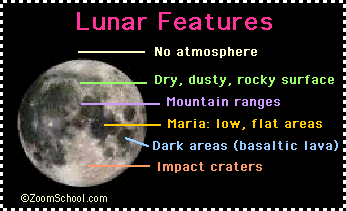 The same side of the moon always faces the Earth. The far side of the moon was first observed by humans in 1959 when the unmanned Soviet Luna 3 mission orbited the moon and photographed it. Neil Armstrong and Buzz Aldrin (on NASA's Apollo 11 mission, which also included Michael Collins) were the first people to walk on the moon, on July 20, 1969. The same side of the moon always faces the Earth. The far side of the moon was first observed by humans in 1959 when the unmanned Soviet Luna 3 mission orbited the moon and photographed it. Neil Armstrong and Buzz Aldrin (on NASA's Apollo 11 mission, which also included Michael Collins) were the first people to walk on the moon, on July 20, 1969.
 If you were standing on the moon, the sky would always appear dark, even during the daytime. Also, from any spot on the moon (except on the far side of the moon where you cannot see the Earth), the Earth would always be in the same place in the sky; the phase of the Earth changes and the Earth rotates, displaying various continents. If you were standing on the moon, the sky would always appear dark, even during the daytime. Also, from any spot on the moon (except on the far side of the moon where you cannot see the Earth), the Earth would always be in the same place in the sky; the phase of the Earth changes and the Earth rotates, displaying various continents.
THE MOON'S ORBIT
 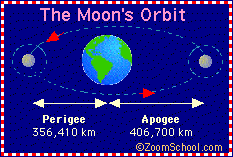 The moon is about 238,900 miles (384,000 km) from Earth on average. At its closest approach (the lunar perigee) the moon is 221,460 miles (356,410 km) from the Earth. At its farthest approach (its apogee) the moon is 252,700 miles (406,700 km) from the Earth. The moon is about 238,900 miles (384,000 km) from Earth on average. At its closest approach (the lunar perigee) the moon is 221,460 miles (356,410 km) from the Earth. At its farthest approach (its apogee) the moon is 252,700 miles (406,700 km) from the Earth.
The moon revolves around the Earth in about one month (27 days 8 hours). It rotates around its own axis in the same amount of time. The same side of the moon always faces the Earth; it is in a synchronous rotation with the Earth.
 The Moon's orbit is expanding over time as it slows down (the Earth is also slowing down as it loses energy). For example, a billion years ago, the Moon was much closer to the Earth (roughly 200,000 kilometers) and took only 20 days to orbit the Earth. Also, one Earth 'day' was about 18 hours long (instead of our 24 hour day). The tides on Earth were also much stronger since the moon was closer to the Earth. The Moon's orbit is expanding over time as it slows down (the Earth is also slowing down as it loses energy). For example, a billion years ago, the Moon was much closer to the Earth (roughly 200,000 kilometers) and took only 20 days to orbit the Earth. Also, one Earth 'day' was about 18 hours long (instead of our 24 hour day). The tides on Earth were also much stronger since the moon was closer to the Earth.
SAROS
The saros is the roughly 18-year periodic cycle of the Earth-Moon-Sun system. Every 6,585 days, the Earth, Moon and Sun are in exactly the same position. When there is a lunar eclipse, there will also be one exactly 6,585 days later.
SIZE
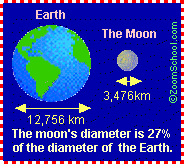 The moon's diameter is 2,159 miles (3,474 km), 27% of the diameter of the Earth (a bit over a quarter of the Earth's diameter). The moon's diameter is 2,159 miles (3,474 km), 27% of the diameter of the Earth (a bit over a quarter of the Earth's diameter).
The gravitational tidal influence of the Moon on the Earth is about twice as strong as the Sun's gravitational tidal influence. The Earth:moon size ratio is quite small in comparison to ratios of most other planet:moon systems (for most planets in our Solar System, the moons are much smaller in comparison to the planet and have less of an effect on the planet).
MASS AND GRAVITY
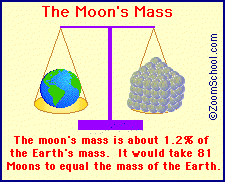 The moon's mass is (7.35 x 10 22 kg), about 1/81 of the Earth's mass. The moon's mass is (7.35 x 10 22 kg), about 1/81 of the Earth's mass.
The moon's gravitational force is only 17% of the Earth's gravity. For example, a 100 pound (45 kg) person would weigh only 17 pounds (7.6 kg) on the Moon.
The moon's density is 3340 kg/m 3. This is about 3/5 the density of the Earth.
 TEMPERATURE TEMPERATURE
The temperature on the Moon ranges from daytime highs of about 130°C = 265°F to nighttime lows of about -110°C = -170°F
ATMOSPHERE
The moon has no atmosphere. On the moon, the sky is always appears dark, even on the bright side (because there is no atmosphere). Also, since sound waves travel through air, the moon is silent; there can be no sound transmission on the moon.
MARE
 Mare (plural maria) means "sea," but maria on the moon are plains on the moon. They are called maria because very early astronomers thought that these areas on the moon were great seas. The first moon landing was in the Mare Tranquillitatis (the Sea of Tranquility). Maria are concentrated on the side of the moon that faces the Earth; the far side has very few of these plains. Scientists don't know why this is so. Mare (plural maria) means "sea," but maria on the moon are plains on the moon. They are called maria because very early astronomers thought that these areas on the moon were great seas. The first moon landing was in the Mare Tranquillitatis (the Sea of Tranquility). Maria are concentrated on the side of the moon that faces the Earth; the far side has very few of these plains. Scientists don't know why this is so.
CRATERS AND RILLES

The lunar crater Aristarchus ( on the NW edge of the Oceanus Procellarum). This huge, circular crater is 25 miles (40 km) in diameter and 2.2 miles (3.6 km) deep (from rim to floor). There is a lot of ejecta (material thrown from the crater at impact) surrounding the crater. |
The surface of the moon is scarred by millions of (mostly circular) impact craters, caused by asteroids, comets, and meteorites. There is no atmosphere on the moon to help protect it from bombardment from potential impactors (most objects from space burn up in our atmosphere). Also, there is no erosion (wind or precipitation) and little geologic activity to wear away these craters, so they remain unchanged until another new impact changes it.
These craters range in size up to many hundreds of kilometers, but the most enormous craters have been flooded by lava, and only parts of the outline are visible. The low elevation maria (seas) have fewer craters than other areas. This is because these areas formed more recently, and have had less time to be hit. The biggest intact lunar crater is Clavius which is 100 miles (160 km) in diameter.
 A rille is a long, narrow valley on the surface of the moon. Hadley Rille is a long valley on the surface of the moon. This rille is 75 miles (125 km) long, 1300 feet (400 m) deep, and almost 1 mile (1500 m) wide at its widest point. It was formed by molten basaltic lava that carved out a steep channel along the base of the Apennine Front (which was explored by the Apollo 15 astronauts in 1971). A rille is a long, narrow valley on the surface of the moon. Hadley Rille is a long valley on the surface of the moon. This rille is 75 miles (125 km) long, 1300 feet (400 m) deep, and almost 1 mile (1500 m) wide at its widest point. It was formed by molten basaltic lava that carved out a steep channel along the base of the Apennine Front (which was explored by the Apollo 15 astronauts in 1971).
MOON OR DOUBLE PLANET?
The Earth and the Moon are relatively close in size (4:1 in diameter, 81:1 in mass), unlike most planet/moon systems. Many people consider the Earth and Moon to be a double planet system (rather than a planet/moon system). The moon does not actually revolve around the Earth; it revolves around the Sun in concert with the Earth (like a double planet system).
LIBRATION
Libration is a rocking movement of the Moon. Librations cause us to view the Moon from different angles at different times, enabling us to see about 59 percent of the Moon's surface from Earth, even though the same side always faces us. There are librations due to variations in the rate of the Moon's orbital motion (longitudinal libration) and to the inclination of the Moon's equator with respect to its orbital plane (latitudinal libration). There is also an apparent libration due to an observer on Earth viewing the Moon from different angles as the Earth rotates (diurnal libration, which occurs each day).
TWO LUNAR MONTHS
The sidereal and synodic lunar months have different lengths. The sidereal month is the amount of time it takes the Moon to return to the same position in the sky with respect to the stars; the sidereal month is 27.321 days long. The synodic month is the time between similar lunar phases (e.g., between two full moons); the synodic month is 29.530 days long.
LUNAR EXPLORATION
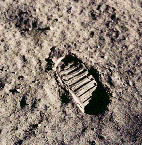
Astronaut Buzz Aldrin's footprint on the moon's Sea of Tranquility, from the Apollo 11 mission in 1969. |
 There have been many missions to the moon, including orbiters missions and moon landings. NASA's Apollo missions sent people to the moon for the first time. Apollo 11's LEM (Lunar Excursion Module) landed on the moon on July 20, 1969 with Neil Armstrong and Edwin "Buzz" Aldrin (Michael Collins was in the orbiter). Neil Armstrong was the first person to set foot on the moon. His first words upon stepping down the Lunar Module's ladder onto the lunar surface were, "That's one small step for man, one giant leap for mankind." Aldrin described the lunar scenery as "magnificent desolation." Apollo 12-17 continued lunar exploration. MOON ROCKS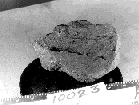 NASA astronauts have retrieved 842 pounds (382 kg) of moon rocks (in many missions), which have been closely studied. The composition of the moon rocks is very similar to that of Earth rocks. Using radioisotope dating, it has been found that moon rocks are about 4.3 billion years old. THE ORIGIN OF THE MOONMost scientists believe that the moon was formed from the ejected material after the Earth collided with a Mars-sized object. This ejected material coalesced into the moon that went into orbit around th Earth. This catastrophic collision occurred about 60 million years after Earth itself formed (about 4.3 billion years ago). This is determined by the radioisotope dating of moon rocks ROCA/BENJAMIN
|
|
|
|
Rispondi |
Messaggio 48 di 113 di questo argomento |
|
|
|
|
Rispondi |
Messaggio 49 di 113 di questo argomento |
|
COLUMBIA, LA PALOMA DE NOE
Columba (constelación)
Columba, Latín para palomo, es una pequeña constelación justo al sur de Canis Major y Lepus. Fue sacada de la constelación Canis Major por Augustin Royer, en 1679.
Dado que fue creada en el siglo XVII, por la separación de una constelación ya existente, no tiene mitología relacionada, de manera independiente.
Puede referirse a la paloma que los Argonautas envían para determinar si pueden pasar por el estrecho del mar negro. También, es la paloma que Nóe utilizó en su arca.

Columba, la Paloma, junto al Can Mayor.

NOTEN EL ARCO IRIS
Belen Map — Satellite Images of Belen
original name: Belén geographical location: Belen, Concepcion, Paraguay, South America geographical coordinates: 23° 27' 58" South, 57° 15' 43" West
detailed map of Belen and near places
 Welcome to the Belen google satellite map! This place is situated in Belen, Concepcion, Paraguay, its geographical coordinates are 23° 27' 58" South, 57° 15' 43" West and its original name (with diacritics) is Belén. See Belen photos and images from satellite below, explore the aerial photographs of Belen in Paraguay. Belen hotels map is available on the target page linked above. Welcome to the Belen google satellite map! This place is situated in Belen, Concepcion, Paraguay, its geographical coordinates are 23° 27' 58" South, 57° 15' 43" West and its original name (with diacritics) is Belén. See Belen photos and images from satellite below, explore the aerial photographs of Belen in Paraguay. Belen hotels map is available on the target page linked above.
http://www.maplandia.com/paraguay/concepcion/belen/belen/
La ubicacion de BELEN en el TROPICO DE CAPRICORNIO, en el contexto al PACTO DE NOE DEL ARCO IRIS, BANDERA PARAGUAYA TIENE COMO EXTREMOS EL ROJO Y EL AZUL E INCLUSO UNA ESTRELLA DE 5 PUNTAS EN EL CENTRO, en GENESIS 9:11 es un obvio nexo CON EL GRIAL e icluso potencialmente interrelacionado con el FIN DEL CALENDARIO MAYA ya que justamente el SOL, LA TIERRA Y EL CENTRO DE LA VIA LACTEA SE PONEN EN UNA SOLA LINEA, osea UN ENLACE ESPIRITUAL CON GALATAS 4:26, justamente en DICHO TROPICO.
En realidad el TROPICO DE CAPRICORNIO ES DE SAGITARIO Y EL TROPICO DE CANCER ES EN GEMINIS en contexto a la PRECESION DE LOS EQUINOCCIOS. SAGITARIO en contexto al ARCO tiene un nexo con BENJAMIN en contexto al ARCO IRIS. Concretamente BELEN es un NEXO CON RAQUEL, LA ESPOSA AMADA DE JACOB, y madre de BENJAMIN (PEQUEÑO). Incluso detras del VIAJE A LA LUNA TAMBIEN TENEMOS EN CONTEXTO A COLUMBIA, UN MENSAJE NEXO CON EL ARCA DE NOE. Esto explica espiritualmente del porque de la ubicacion de ASUNCION DEL PARAGUAY EN CONTEXTO A LA MESOPOTAMIA ARGENTINA COMO LAODICEA, QUE ES LA IGLESIA DE LA ILUMINACION SEGUN APOCALIPSIS 3:14, en contexto a ANTIOQUIA AL SUR DEL MONTE DE ARARAT Y al norte de la mesopotamia en contexto a BABILONIA cuyos rios son el EUFRATES Y EL TIGRIS. RECORDEMOS que la antigua BABILONIA /BABY-LON/BEBE ESTABA EN EL PARALELO 33.
|
|
|
|
Rispondi |
Messaggio 50 di 113 di questo argomento |
|
TEMAN TIENE LA MISMA DEFINICION QUE BENJAMIN
(heb. Têmn, "a la mano derecha [diestra]" o "al sur"). Nieto de Esaú (Gn. 36: 11) y el sector habitado por sus descendientes (Jer. 49: 20; Am. 1: 12-1 Abd. 9; Hab. 3: 3). Probablemente se encontraba en el extremo norte de Edom (Ez. 25: 13). Uno de los reyes de Edom era de Temán (Gn. 36: 34), y uno de los amigos de Job pudo haber sido de allí también (Job 2: 11). Los temanitas eran famosos por su sabiduría (Jer. 49: 7). En el Mapa V, B-7 se señalan 2 posibles ubicaciones de este lugar. Leer más: Diccionario Biblico Gratis - Temán |
|
|
|
Rispondi |
Messaggio 51 di 113 di questo argomento |
|
|
|
|
Rispondi |
Messaggio 52 di 113 di questo argomento |
|
Canis Major loyally follows its mythical master, Orion, across the southern skies of winter.
The brightest star in Canis Major also is the brightest in the entire night sky — brilliant Sirius, which is just 8.6 light-years away. That's only twice as far as our closest stellar neighbor. Because it is the brightest star of the Great Dog, Sirius is known as the Dog Star. Its first appearance in the dawn sky in August heralds the "dog days" of summer.
Sirius is actually a double star. The star that we see as Sirius is about 20 times brighter than the Sun. It is also hotter and more massive than the Sun. Its companion is known as Sirius B, and is nicknamed The Pup. It is a white dwarf -- the hot, dense core of a star that was once like Sirius itself. At the end of its life, the star blew its outer layers into space, leaving only the core. Sirius B is as massive as the Sun but less than one percent as bright. It shines simply because it's still hot.
Canis Major's second-brightest star is Adhara. It is well below Sirius, in one of the dog's legs. It is about 425 light-years away. It emits about a thousand times more visible light than Sirius does, so if it were moved to the same distance as Sirius, it would look about 200 times brighter than Sirius does.
Because the surface of Adhara is extremely hot, the star emits more ultraviolet energy than visible light. If our eyes were tuned to the ultraviolet, Adhara would outshine every other star in the night sky.
One interesting sight in Canis Major is a star cluster known as M41, which is about 2,300 light-years away. It's visible to the unaided eye as a faint smudge of light below Sirius. Binoculars or a small telescope reveal a swarm of several dozen stars.
Featured on
January 31, 2009
Dozens of stars sparkle in M41, a star cluster in the constellation Canis Major, the big dog. The cluster includes several old, bloated stars known as red giants, which shine bright orange. The cluster is about 2,300 light-years away. Under very dark skies, it is visible to the unaided eye as a faint smudge of light. [NOAO/AURA/NSF]
|
|
|
|
Rispondi |
Messaggio 53 di 113 di questo argomento |
|
YHWH CODIFICO EN EL VATICANO LA LLAVE DE DAVID EN FUNCION A SIRIO-LA PIRAMIDE DE LA PLAZA DE SAN PEDRO ES DICHA LLAVE-EN UN CONTEXTO A QUE ROMA TIENE 7 COLINAS/PLEYADES/TAURO/LUNA CRECIENTE YA QUE LOS CUERNOS DEL TORO TAMBIEN SON UN SIMBOLO DE DICHA LUNA LA PIRAMIDE/LLAVE ES EL GRIAL-DICHO OBELISCO ESTA EN EL PARALELO 41 Y TIENE 41 METROS-¿QUE NEXO HAY CON EL 13/10 EN EL CONTEXTO A QUE DICHO DIA NOS CAE EN LA SEMANA NUMERO 41?
16:19 Y a ti te daré las llaves del reino de los cielos; y todo lo que atares en la tierra será atado en los cielos; y todo lo que desatares en la tierra será desatado en los cielos.
AMIGO NO PROMUEVA EL ROBO NI SE DEJE ROBAR
ROSARIO EN EL PARALELO 33
| key in Simple Gematria Equals: 41 |
( |
k
11 |
e
5 |
y
25 |
) |
| key in Simple Gematria Equals: 41 |
( |
k
11 |
e
5 |
y
25 |
) |
Canis Major loyally follows its mythical master, Orion, across the southern skies of winter.
The brightest star in Canis Major also is the brightest in the entire night sky — brilliant Sirius, which is just 8.6 light-years away. That's only twice as far as our closest stellar neighbor. Because it is the brightest star of the Great Dog, Sirius is known as the Dog Star. Its first appearance in the dawn sky in August heralds the "dog days" of summer.
Sirius is actually a double star. The star that we see as Sirius is about 20 times brighter than the Sun. It is also hotter and more massive than the Sun. Its companion is known as Sirius B, and is nicknamed The Pup. It is a white dwarf -- the hot, dense core of a star that was once like Sirius itself. At the end of its life, the star blew its outer layers into space, leaving only the core. Sirius B is as massive as the Sun but less than one percent as bright. It shines simply because it's still hot.
Canis Major's second-brightest star is Adhara. It is well below Sirius, in one of the dog's legs. It is about 425 light-years away. It emits about a thousand times more visible light than Sirius does, so if it were moved to the same distance as Sirius, it would look about 200 times brighter than Sirius does.
Because the surface of Adhara is extremely hot, the star emits more ultraviolet energy than visible light. If our eyes were tuned to the ultraviolet, Adhara would outshine every other star in the night sky.
One interesting sight in Canis Major is a star cluster known as M41, which is about 2,300 light-years away. It's visible to the unaided eye as a faint smudge of light below Sirius. Binoculars or a small telescope reveal a swarm of several dozen stars.

|
|
La ciudad del vaticano es una ciudad-estado que se encuentra dentro de Roma. Su población se calcula en menos de 1.000 habitantes y su extensión en 0.439 Km2.
Allí se ubica la santa sede de la Iglesia Católica, máxima autoridad y gobierno con el papa a la cabeza. La santa sede posee personalidad jurídica propia y mantiene relaciones diplomáticas con los demás estados. En el interior del Vaticano encontramos la basílica de San Pedro, la tumba de San Pedro y el museo Vaticano.
Coordenadas: 41 54 07N, 12 27 25E
|
|
The 5 above articles in my other older blog each also contains some further extrapolation & elucidation of the multiple synchronistic themes embedded within the riddle, thus anyone interested in these things is strongly advised to read them as well in order to truly get out of the mental cage and think out of the box as required. Now let’s go back to the “KEY & SQUARE” at the St Peter’s Square (Piazza) and peer somewhat deeper into the total Obelisk height of 41 meters as a crucial clue:
41 METERS HIGH
41 DEGREE PARALLEL
Exact latitude of the Obelisk at the Vatican is: 41.90 N
|
|
|
|
 Primo Primo
 Precedente
39 a 53 de 113
Successivo Precedente
39 a 53 de 113
Successivo Ultimo
Ultimo
|


 La Torá describe a Rajel como una chica con características muy hermosas y una piel muy bella, y a Lea como a una chica con ojos tiernos (Génesis 29:17). Es inusual para la Torá derramar tinta en ilustrar a la gente y lugares que menciona.
La Torá describe a Rajel como una chica con características muy hermosas y una piel muy bella, y a Lea como a una chica con ojos tiernos (Génesis 29:17). Es inusual para la Torá derramar tinta en ilustrar a la gente y lugares que menciona.




 The moon is
The moon is 
